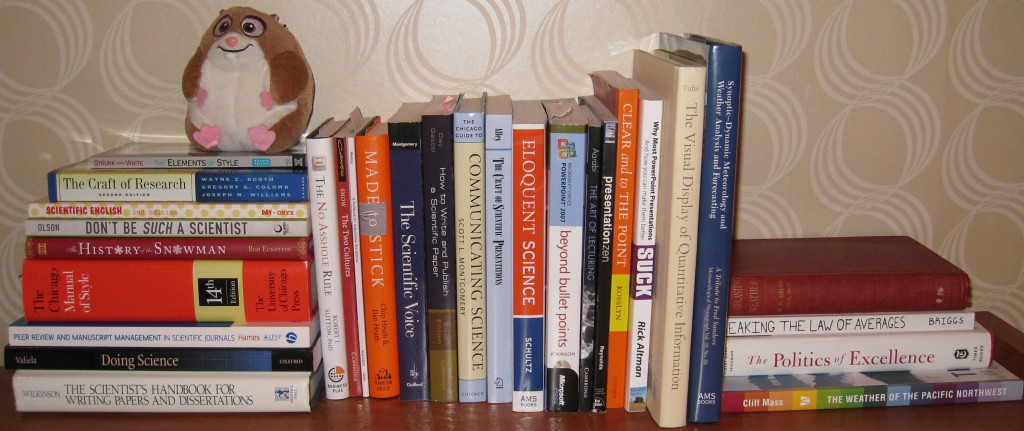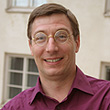Recommended Reading
 Previously, I provided three items of essential reading. Here are other books that I highly recommend for improving your scientific communication skills.
Previously, I provided three items of essential reading. Here are other books that I highly recommend for improving your scientific communication skills.
HIGHLY RECOMMENDED READING ON WRITING
Cook (1986): Line by Line: How to Edit Your Own Writing delivers a thorough accounting of the editing process. The book deals mainly with sentence-level revisions and contains numerous examples.
Day and Gastel (2006): How to Write and Publish a Scientific Paper is one of the most popular and thorough resources on this topic. Earlier editions were authored by Day alone and are just as good.
Montgomery (2003): The Chicago Guide to Communicating Science is a well- written, informative, and motivational book. Chapter 5 “Writing very well: Opportunities for creativity and elegance” is exceptional, providing the next step to scientific-writing brilliance after Eloquent Science.
Perelman et al. (1998): The Mayfield Handbook of Technical and Scientific Writing is another popular book that deals more with the mechanics of preparing and writing a scientific paper than the other sources listed here. This book presents excellent material on modes of paragraph development with examples and other rules of grammar. It is available online at www.mhhe.com/mayfieldpub/tsw/home.htm.
Schall (2006): Style for Students has clear explanations, lots of examples, tables on active verbs, and one of the best discussions of how to cite references that I have found. The book has been updated and is available online at www.e-education.psu.edu/styleforstudents.
U.S. Air Force (2004): The Tongue and Quill. Despite being authored by the military, this guide can be useful for anyone. The manual stresses communication philosophy and connecting with the audience. Several chapters address e-mail, punctuation, capitalization, and grammar.
Williams (2006): Style: Lessons in Clarity and Grace (10th Edition) or any edition, forces further clarity and grace in your writing beyond prescriptive rules.
RECOMMENDED READING ON WRITING
Alley (1996): The Craft of Scientific Writing. Given the motivational challenges that we all face when writing, I found precious little information in most scientific writing books on this topic. Chapter 17 “Actually sitting down to write,” however, provides a good deal of information.
Alley (2000): The Craft of Editing: A Guide for Managers, Scientists, and Engineers focuses on how to edit others’ work, especially when in a supervisory role or a collaboration.
Anderson (1999): Technical Communication: A Reader-Centered Approach is a broad and detailed book for all types of technical communication, not just journal articles. The best material in this book is determining your audience, defining your objectives for a manuscript, planning persuasive strategies, brainstorming, free-writing (a form of brainstorming), writing the first draft, and defining the criteria for classification schemes.
Ebel et al. (2004): The Art of Scientific Writing: From Student Reports to Professional Publications in Chemistry and Related Fields is a thorough and academic, albeit not particularly practical, book. The best sections are those on decisions an author must make prior to publication, and on citations. One chapter discusses how to acquire, build, and manage your own literature collection.
Fairbairn and Fairbairn (2005): Writing Your Abstract: A Guide for Would-Be-Conference Presenters. Imagine a whole book about writing conference abstracts! Here is one book that can be read in one sitting, has numerous examples and writing exercises, and offers a five-minute daily writing workout to stimulate the reluctant writer.
Lipton (1998): The Science Editor’s Soapbox: An Aid for Writers of Scientific and Technical Reports. This self-published guide from a former editor for the American Society for Horticultural Science’s HortScience presents a collection of his essays on effective scientific writing. This book is applicable to other scientists, not only those in horticultural science.
Wilkinson (1991): The Scientists’ Handbook for Writing Papers and Dissertations presents a thorough, academic analysis of the different sections of a scientific manuscript, drawing examples from numerous sciences.
Williams (2004): Sin Boldly!: Dr. Dave’s Guide To Writing The College Paper is aimed more at writing effective essays in college courses, not necessarily scientific papers. It is a non–politically correct, entertaining read. Although I would argue with some of his admonitions, his points are presented clearly.
Unless specifically noted, the AMS follows the press style in The Chicago Manual of Style (The University of Chicago Press 2003), the standard reference for press style in many U.S. publishing houses.
RECOMMENDED READING ON ORAL PRESENTATIONS
Aarabi (2007): The Art of Lecturing: A Practical Guide to Successful University Lectures and Business Presentations is an exceptional resource for those who give university lectures, but the lessons also apply to giving presentations. One of the strengths of this book is the discussion of how the audience receives and processes information.
Alley (2003): The Craft of Scientific Presentations: Critical Steps to Succeed and Critical Errors to Avoid provides much insight into scientific presentations through ten critical errors that many speakers make. This book also includes some of the best published material on dealing with nervousness and questions. What I like most about his book are the examples of good and bad habits drawn from Nobel Prize winners and other less-celebrated scientists.
Altman (2007): Why Most PowerPoint Presentations Suck, 2nd Edition is a light-hearted and readable book that dives a bit deeper into the mechanics of using PowerPoint to enhance your presentations.
Heath and Heath (2007): Made to Stick: Why Some Ideas Survive and Others Diediscusses the six factors that make ideas “sticky.” Applying these to your science and presentations can help make them more memorable: simplicity, unexpectedness, concreteness, credibility, emotional, and stories.
Kosslyn (2007): Clear and to the Point: 8 Psychological Principles for Compelling PowerPoint Presentations provides a thorough documentation of how the style and structure of our slides determines whether and how the audience recognizes and remembers our presentation.
The Oceanography Society (2005): Scientifically Speaking is a good all-purpose resource for poster and oral presentations, as well as practical advice about answering questions.
RECOMMENDED READING ON RESEARCH
Booth et al. (2003): The Craft of Research has chapters about defining research questions, making good arguments, providing evidence, and writing up your research. This is one of the most accessible books I am aware of that deals with the practical side of doing research.
Valiela (2001): Doing Science: Design, Analysis, and Communication of Scientific Research discusses, among other aspects of scientific research, the design of research studies, with particular emphasis on proper statistical analyses.
Weston (2009): A Rulebook for Arguments delves into 45 rules for constructing effective arguments. Many of these rules are discussed in various places throughout this book, but, here, they are collected in a short readable 88-page guide.


